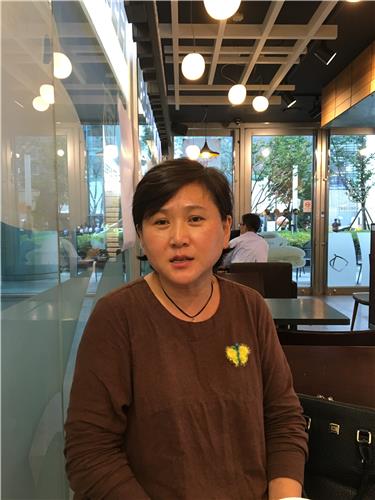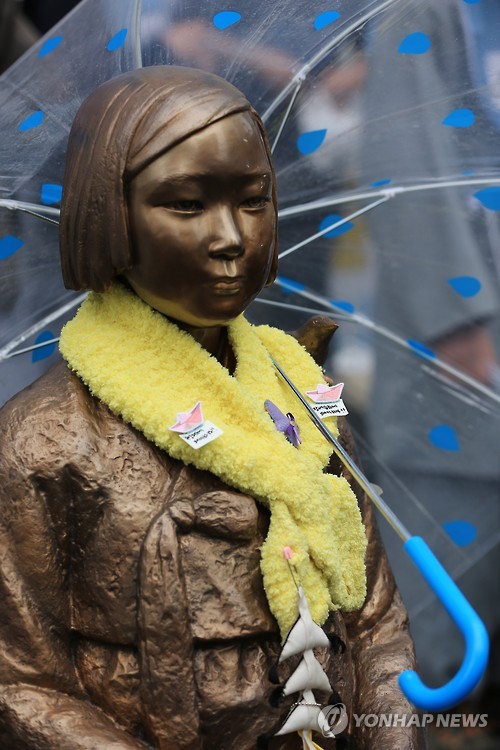- California Assembly OKs highest minimum wage in nation
- S. Korea unveils first graphic cigarette warnings
- US joins with South Korea, Japan in bid to deter North Korea
- LPGA golfer Chun In-gee finally back in action
- S. Korea won’t be top seed in final World Cup qualification round
- US men’s soccer misses 2nd straight Olympics
- US back on track in qualifying with 4-0 win over Guatemala
- High-intensity workout injuries spawn cottage industry
- CDC expands range of Zika mosquitoes into parts of Northeast
- Who knew? ‘The Walking Dead’ is helping families connect
Deciphering symbolism of girl statue
SEOUL, Sept. 6 (Yonhap) — The statue of a girl in front of the Japanese Embassy in Seoul has her heels lifted indefinitely off the ground, symbolizing the uneasy lives “comfort women” have lived.
“The unrested heels tell the life stories of those women who couldn’t have their presence properly recognized on this land and who couldn’t live an ordinary and comfortable life with nothing to depend on,” said Kim Seo-kyung, the creator of the bronze statue.
Since its erection on a road just across from the Japanese Embassy in central Seoul in December 2011, the girl statue has been the main symbol of Korean women fighting for an apology and compensation for Japan’s sexual enslavement of them, when they were young women during its colonial rule of the Korean Peninsula (1910-45).

Historians estimate that up to 200,000 women, mostly young Korean women, were forced to work at front-line brothels as comfort women for the Imperialist Japanese Army before and during World War II.
Since the first victim came to testify in 1991, a total of 245 victims have been officially registered. Currently only 40 of them are alive after most died of old age.
In December, South Korea and Japan reached a landmark deal to settle the grievances of the victims, based on which Japan injected 1 billion yen (US$9.6 million) into a fund last month of a South Korean foundation aimed at “recovering the honor and healing the scars” of the sexual slavery victims.
The deal, however, catapulted the girl statue to the forefront of the neighbors’ diplomatic discourse, with Japan increasing its calls on Seoul to remove the civic group-installed girl statue in return for the financial contribution.
But what do the details of the girl statue symbolize?
The life-size statue of the seated girl, who is 160 centimeters tall, is a throwback to the women’s childhoods when they were forced into wartime sexual servitude.
Clad in “hanbok,” the traditional Korean dress popularly worn at that time, the girl’s hair is roughly cut to ear length, symbolizing the deprivation of the women’s right to self-determination.
“The allusion is that the girl’s hair was cut against her will. If the haircut was her choice, it would have been cut nicely,” Kim, the sculptor, said. “The hair also means her ties with her family and her country were severed with the sexual enslavement.”

Cast under the young girl is a mosaic shadow of an old woman, a representation of the comfort women’s fragmented and shadowed lives, as well as the suffering they had from their childhoods all the way to now as elderly women.
At the heart of the mosaic of black gravel sits a fluttering white butterfly, exuding hope for the victims’ reincarnation into a better world, according to a book recently published by Kim and her husband Kim Eun-sung, who co-produced the statue.
An empty chair flanking the tight-lipped girl is an invitation for comfort women who are already deceased, as well as anyone to join the victims’ arduous fight.
“Anyone who passes by this statue can sit on the chair and ponder what makes the old women continue their fight for over 20 years,” Kim said, referring to the victims’ long-running demonstration in front of the Japanese Embassy.
Since their first session in 1992, the Korean Council for the Women Drafted for Military Sexual Slavery by Japan, the key advocacy group for the comfort women issue, and several victims held their 1,246th weekly demonstration last Wednesday, demanding a proper apology from the Japanese government and protesting Japan’s calls for the statue’s removal.
Japan made an official written apology in the December settlement, but the activists argue Japan’s legal responsibility for wartime sexual atrocities was not reflected there.
The girl’s quest for freedom and peace is embodied in a small bird perched on her shoulder, which also plays the role of spiritually linking surviving victims to those who already passed away, Kim said.
Loaded with such heavy symbolism, the girl statue, with clenched hands, is staring right into the embassy site, where construction is under way to rebuild the embassy.
“I put special attention to making the girl have a dignified look … rather than anger, sadness or weakness,” the sculptor said. “It’s an expression of the determination that they will not give up until they have an apology.”
These symbols were surely at play when the statue became an object of vandalism by a conservative Japanese activist in 2012.
South Korea is still in a protracted process to try Nobuyuki Suzuki in court for tying a wooden post to the girl statue. The 90-centimeter white post carried a message of Japan’s territorial claims to the South Korean islets of Dokdo.
A 30-something South Korean woman also came under a police investigation in June after hammering the girl statue’s head, which left several minor scratches on the sculpture.
The girl statue has experienced, however, more welcoming acceptance among supporters who place mufflers around her neck during wintertime and an umbrella over her in rainy days.
Kim said the girl statue should remain in the present place to keep conjuring up Japan’s past wrongdoings and prevent a repetition of the tragedy.
“Japan wants to whitewash its wrongdoings one by one, but our role is to bring them out and shed light on them,” she said in a recent interview with Yonhap News Agency. “Only through these acts can the offender be constantly reminded of its misdeeds and a repetition of them can be prevented.”
So far, a total of 44 girl statues have been erected, including four installed in the United States, Canada and Australia, and Kim said many more statues are in the making.













how to fall
September 7, 2016 at 2:50 AM
Forum
and chairs
September 7, 2016 at 9:48 AM
Says-It.com
hair knots
September 8, 2016 at 2:20 PM
APAH MC Study Guide.doc – AP Art History with …